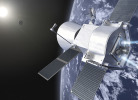BepiColombo - PSA
BepiColombo

BepiColombo will be ESA's first mission to Mercury. Due for launch in 2018, the mission will take approximately 6 years to arrive at Mercury, after which it will endure temperatures as high as 350 degrees during its 1 year nominal mission and possible 1 year extension. BepiColombo consists of two separate spacecraft that will orbit the planet. ESA is building the Mercury Planetary Orbiter (MPO), and the Japanese space agency ISAS/JAXA will contribute the Mercury Magnetospheric Orbiter (MMO). The MPO will study the surface and internal composition of the planet, while MMO will study Mercury's magnetosphere.
Mercury Magnetospheric Orbiter Instruments
MDMMercury Dust Monitor
MDM will clarify the dust environment at Mercury's region of the solar system. No public data available yet |
MGFMercury Magnetometer
MGF is a magnetometer which will provide a detailed description of the magnetosphere and relation and interaction with solar wind and planetary magnetic field. No public data available yet |
MPPEMercury Plasma Particle Experiment
MPPE is a comprehensive instrument package for plasma, high energy particle and energetic neutral atom measurements. MPPE is a set of particle sensors: MSA (Mass Spectrum Analyzer), MIA (Mercury Ion Analyzer), MEA (Mercury Electron Analyzer), HEP (High Energy Particles ion and electron) and ENA (Energetic Neutral Atom). No public data available yet |
MSASIMercury Sodium Atmospheric Spectral Imager
MSASI is a high-dispersion Fabry-Perot imager working in the spectral range around sodium D2 emission (589 nm). MSASI will address a wealth of fundamental scientific questions pertaining to the Mercury's exosphere: abundance, distribution and dynamics of sodium in the exosphere. No public data available yet |
PWIPlasma Wave Instrument
PWI will provide remote-sensing observations of electric fields, plasma waves, and radio waves in the Hermean magnetosphere and exosphere. The PWI consists of three sets of receivers (Electric Waveform Onboard, EWO, Spectroscopie Ondes Radio & Bruit Electrostatique Thermique, SORBET, and Active Measurement of Mercury's Plasma, AM2P), connected to two sets of electric field sensors (Mercury Electric Diled In-Situ Tool, MEFISTO and Wire-Probe anTenna, WPT) and two kinds of magnetic field sensors (Low Frequency Search Coils, LF-SC and Dual-Band Search Coil, DB-SC). No public data available yet |
Mercury Planetary Orbiter Instruments
BELABepiColombo Laser Altimeter
The BepiColombo Laser Altimeter will characterize and measure the figure, topography, and surface morphology of Mercury. It will provide absolute topographic height and position with respect to a Mercury centered coordinate system. No public data available yet |
ISAItalian Spring Accelerometer
This 3-axis accelerometer will measure inertial accelerations produced on the MPO structure by the incoming solar visible radiation and by the planet albedo. In combination with MORE, ISA will give information on Mercury's interior structure and test Einstein's theory of the General Relativity. No public data available yet |
MAGMercury Magnetometer
Detailed investigations of the planetary magnetic field, its source and its interactions with the solar wind, contributing to our understanding of the origin, evolution and current state of the planetary interior. No public data available yet |
MERTISMercury Thermal Infrared Spectrometer
MERTIS is an IR-imaging spectrometer (7-14 microns) with a spectral resolution of 90nm. MERTIS will study Mercury's surface composition, identify rock-forming minerals, map the surface mineralogy, and measure the surface temperature and thermal inertia. No public data available yet Visit website |
MGNSMercury Gamma ray and Neutron Spectrometer
MGNS will measure the elemental composition of the Hermean surface / sub-surface. In addition MGNS will determine the regional distribution of volatile depositions in permanently shadowed areas at the poles, and provide a map of column density of these depositions. No public data available yet |
MIXSMercury Imaging X-ray Spectrometer
MIXS will produce global elemental abundance maps of the key-rock forming elements on Mercury's surface to an accuracy of 10-20%. MIXS will also try to confirm whether the auroral zone, where energetic particles interact with the surface, is an intense source of continuum and line X-rays. No public data available yet |
MOREMercury Orbiter Radio science Experiment
MORE data will help to determine the gravity field of Mercury as well as its internal structure, and the size and physical state of its core. With ISA, it will test theories of gravity with unprecedented accuracy. It will also measure the gravitational oblateness of the Sun. No public data available yet Visit website |
PHEBUSProbing of Hermean Exosphere by Ultraviolet Spectroscopy
PHEBUS is a dual FUV-EUV spectrometer working in the 55-315nm wavelength range devoted to the characterisation of Mercury's exosphere composition and dynamics, and furthering our understanding of the complex coupled surface-exosphere-magnetosphere system. No public data available yet |
SERENASearch for Exosphere Refilling and Emitted Neutral Abundances
This instrument comprises two Neutral Particle Analyzers (ELENA and STROFIO) and two Ion Spectrometers (MIPA and PICAM) that will study the composition, distribution, source and sink processes of Mercury's neutral and charged particle environment. No public data available yet Visit website |
SIMBIO-SYSSpectrometers and Imagers for MPO BepiColombo Integrated Observatory System
SIMBIO-SYS is an integrated package that will complete high resolution stereo imaging and spectroscopic investigations of the Hermean surface. The package will examine the geology, volcanism, global tectonics, surface age, composition, and geophysics of Mercury. No public data available yet |
SIXSSolar Intensity X-ray Spectrometer
SIXS will perform measurements of X-rays and particles of solar origin at Mercury. The instrument will be used to calibrate data from MIXS, and will also study temporal and spectral variability of the solar X-ray corona, and the behaviour and classification of solar flares. No public data available yet |
MCAM Mercury Monitoring Camera
The BepiColombo Monitoring Cameras are a set of three cameras mounted to the Mercury Transfer Module to monitor deployment and actuation of various spacecraft components (solar arrays, antennae, magnetometer boom) etc. Data are released approximately one-week after downlink and are available here
|
Data Access
Browse FTP
Mercury Magnetospheric Orbiter Data
- MDM
- MGF
- MPPE
- MSASI
- PWI
Mercury Planetary Orbiter Data
- BELA
- ISA
- MAG
- MERTIS
- MGNS
- MIXS
- MORE
- PHEBUS
- SERENA
- SIMBIO-SYS
- SIXS
